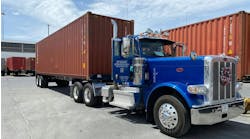Squinting through the gathering gloom of rolling blackouts and rising energy costs, it has been impossible to spot the slightest flicker of good news in the California energy crisis. Even the most “every cloud has a silver lining” optimists have crept quietly away in dismay to check their supplies of candles and firewood. It is a special pleasure, therefore, to report the arrival of a bona fide silver lining, delivered (of course) by trucks.
A refuse fleet in San Diego County has helped to pave the way for construction of a sorely needed power plant in Southern California, and in the process has created a project template that may help other fleets across the county afford the switch to alternative-power vehicles. Waste Management Inc. and the PG&E National Energy Group joined forces last fall in a unique program. The companies are using emissions reductions in the refuse fleet to offset the emissions from the Otay Mesa Generating Project, a 500-megawatt plant now under construction.
Here's how it works: Like a number of other local governments, San Diego County manages its air quality with a regulatory framework that requires new sources of emissions to be offset by emissions reductions elsewhere. In most cases, these “offsets” have come from reductions at other stationery sources, like power plants or manufacturing facilities.
According to Don Payne, manager of corporate communications for Waste Management, this project is the first one in the country to offset emissions from a new power plant by reducing emissions from a mobile source. “Under the plan, Waste Management is replacing 120 of our diesel-fueled trucks with natural gas-powered Mack MR and LE Series vehicles. The trade-out began in January with the delivery of the first 30 trucks, and will continue over the next 18 months,” he explains.
“The conversion will reduce emissions from our fleet by more than 50%, or the equivalent of taking about 9,200 new passenger cars off the road,” Payne adds. “The credits for this reduction will be used to offset the emissions from the new power plant.”
To compensate Waste Management for their pollution credits, PG&E is paying the difference in cost between replacing the 120 trucks with new diesel-powered vehicles and the more expensive LNG-fueled units. The energy company is also paying for construction of a new LNG fueling station that will be available for other fleets to use as well.
While it took the cooperation and help of a number of regulatory agencies to craft and implement the plan, a template now exists for similar projects. This is good news for other fleets considering a switch to LNG, CNG or another approved low-emissions power source.
According to Cliff Gladstein of Gladstein and Assoc., the California-based firm hired by PG&E to identify a fleet partner for its project, opportunities are the greatest for regional or local high-mileage fleets. “Companies that operate within one of the many EPA-designated non-attainment areas, burn more than 10,000 gallons of diesel per vehicle per year, and can return to a home base for fueling are the most likely candidates for programs like this,” he says. “There has to be a good economic rationale. Fleets may be competing against other projects that offer cheaper pollution credits, for instance.”
For fleets that fit the profile, however, the lessons learned in California may finally make the use of a variety of alternative power options viable. And with pressures mounting to reduce exhaust emissions it may be just in the NOx of time.


